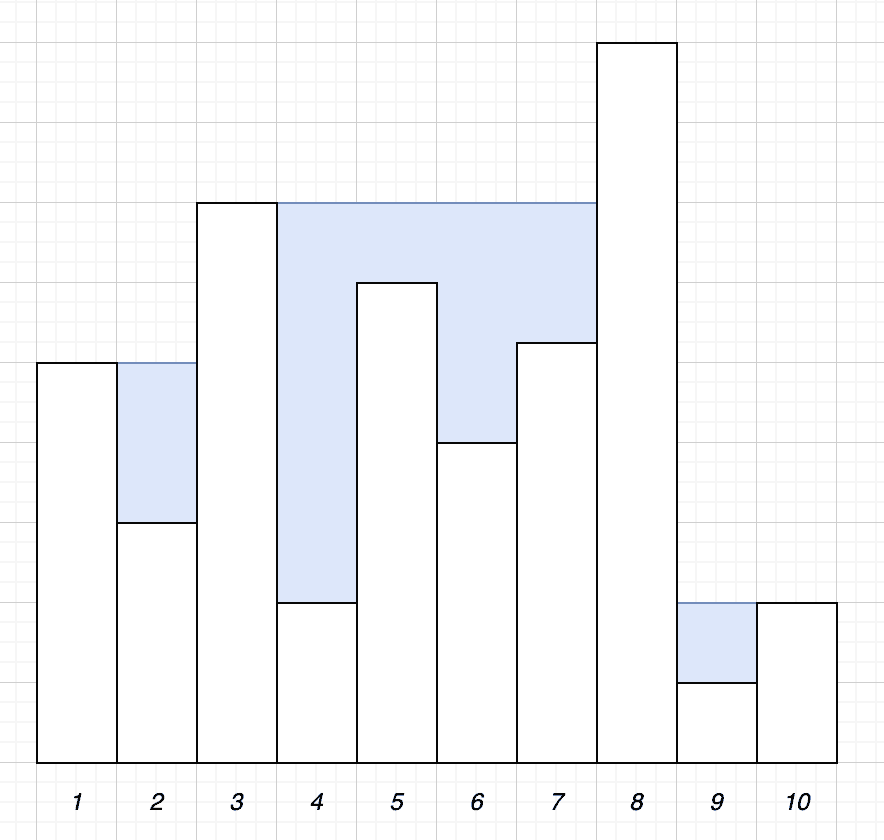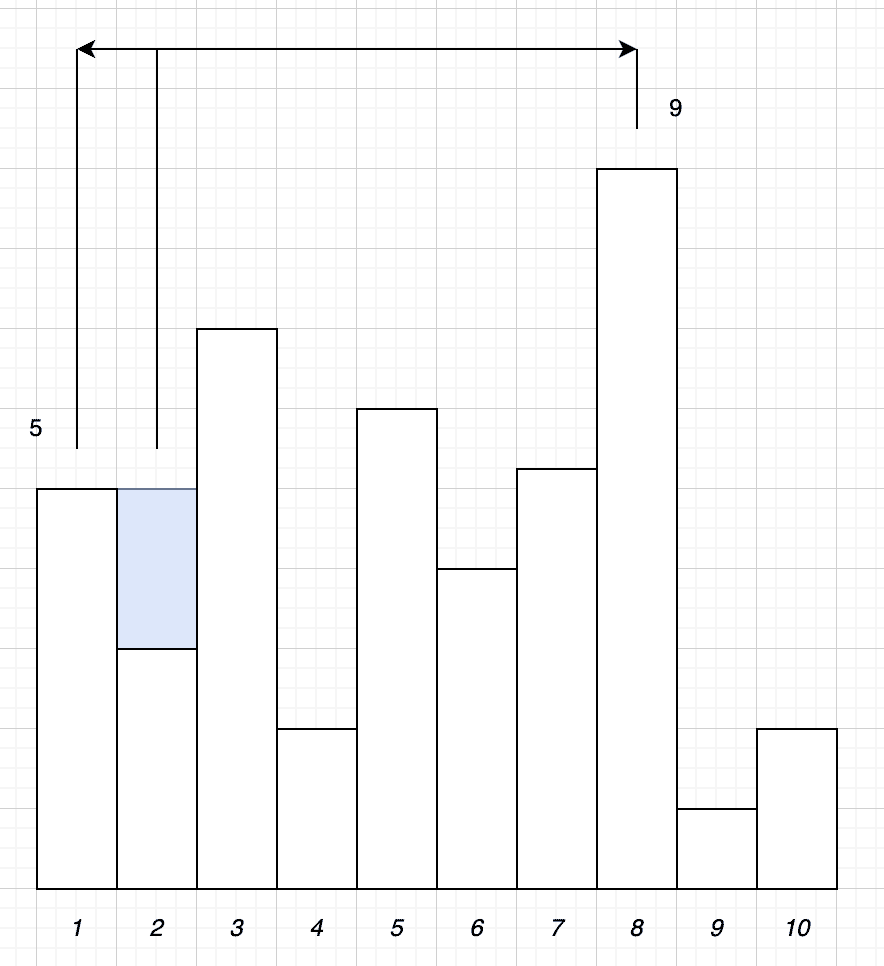1. 问题概述
在本教程中,我们将探讨一个经典的编程问题:给定一组高度不同的塔,计算它们之间能够蓄积的最大水量。
水会积聚在相邻塔之间形成的凹槽中,蓄水量由左右两侧最高塔中较矮的一侧决定。我们的目标是根据任意输入的塔序列,计算出总共能蓄积多少单位的水。
例如,以下是一组塔的高度分布:

图中,总共蓄积了 14 单位水:
- 塔 1 和塔 3 之间蓄积了 2 单位
- 塔 3 和塔 8 之间蓄积了 11 单位
- 塔 8 和塔 10 之间蓄积了 1 单位
2. 初级解法(暴力法)
基本思路是:逐个计算每个塔上方能蓄积的水量。
注意:
- 第一个和最后一个塔上方无法蓄水。
- 每个中间塔的蓄水量由其左右两侧最高塔中较矮的那一侧决定。
2.1. 实现逻辑
我们通过两层嵌套循环来找出每个塔左侧和右侧的最高塔,然后计算差值作为该位置的蓄水量。
Java 示例代码如下:
int NaiveAlgorithm(int[] towers) {
int water = 0;
for (int i = 1; i < towers.length - 1; i++) {
int maxLeft = 0, maxRight = 0;
// 找左边最高的塔
for (int l = 0; l < i; l++) {
maxLeft = Math.max(maxLeft, towers[l]);
}
// 找右边最高的塔
for (int r = i + 1; r < towers.length; r++) {
maxRight = Math.max(maxRight, towers[r]);
}
int minLeftRight = Math.min(maxLeft, maxRight);
if (minLeftRight > towers[i]) {
water += (minLeftRight - towers[i]);
}
}
return water;
}
2.2. 示例解析
以塔 2 为例:
- 左侧最高是塔 1(高度为 5)
- 右侧最高是塔 8(高度为 9)
- 最小值为 5,当前塔高为 3,因此可蓄水 2 单位

2.3. 时间复杂度分析
- 时间复杂度:O(n²)
- 空间复杂度:O(1)
由于每座塔都要扫描其左右两侧所有塔,导致效率较低,尤其当塔的数量很大时会明显拖慢程序性能。
3. 双向扫描优化解法
为了优化暴力法的性能瓶颈,我们可以采用预处理的方式,提前计算每个塔左侧和右侧的最大高度。
3.1. 实现逻辑
我们进行两次扫描:
- 从左到右扫描:记录每个塔左侧最高的塔的高度。
- 从右到左扫描:记录每个塔右侧最高的塔的高度,并同时计算该位置的蓄水量。
Java 示例代码如下:
int TwoPassAlgorithm(int[] towers) {
int n = towers.length;
int[] maxLeft = new int[n];
int currentMax = 0;
// 从左往右记录每个位置左侧最高塔
for (int i = 0; i < n; i++) {
currentMax = Math.max(currentMax, towers[i]);
maxLeft[i] = currentMax;
}
currentMax = 0;
int water = 0;
// 从右往左记录右侧最高塔并计算蓄水量
for (int i = n - 1; i >= 0; i--) {
currentMax = Math.max(currentMax, towers[i]);
int limit = Math.min(maxLeft[i], currentMax);
if (limit > towers[i]) {
water += (limit - towers[i]);
}
}
return water;
}
3.2. 示例解析
以塔 10 为例:
- 左侧最高是 9,右侧最高是 2
- 最小值是 2,当前塔高是 2,无法蓄水
以塔 9 为例:
- 左侧最高是 9,右侧最高是 2
- 最小值是 2,当前塔高是 1,可蓄水 1 单位

3.3. 性能分析
- 时间复杂度:O(n)
- 空间复杂度:O(n)
✅ 优点:
- 时间效率显著提升,尤其适合大规模输入数据
- 逻辑清晰,便于调试
❌ 缺点:
- 使用了额外数组,空间开销增加
- 理解和维护成本略高于暴力法
4. 总结与权衡
我们讨论了两种解决蓄水问题的方法:
| 方法 | 时间复杂度 | 空间复杂度 | 适用场景 |
|---|---|---|---|
| 暴力法 | O(n²) | O(1) | 小规模输入,代码简单 |
| 双向扫描法 | O(n) | O(n) | 大规模输入,性能优先 |
在实际开发中,我们需要根据项目需求权衡时间和空间的取舍。
⚠️ 踩坑提示:
- 不要盲目追求时间效率,忽略空间成本
- 理解算法原理比背诵代码更重要,否则容易在维护中踩坑
✅ 最佳实践建议:
- 面对类似问题,优先考虑是否可以使用预处理或双指针优化
- 熟悉常见算法优化技巧,例如“空间换时间”、“一次遍历”等